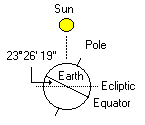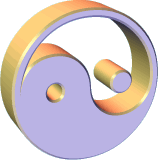|
By observing the sky, recording the Dipper's positions
and watching the shadow of the Sun from an 8-foot (Chinese measurement)
pole, ancient Chinese determined the four directions. The direction of
sunrise is the East; the direction of sunset is the West; the direction
of the shortest shadow is the South and the direction of the longest
shadow is the North. At night, the direction of the Polaris star is the
North.
They noticed the seasonal changes. When the Dipper
points to the East, it's spring; when the Dipper points to the South,
it's summer; when the Dipper points to the West, it's fall; when the
Dipper points to the North, it's winter.
|
When observing the cycle of the Sun, ancient Chinese simply
used a pole about 8 feet long, posted at right angles to the ground and
recorded positions of the shadow. Then they found the length of a year is
around 365.25 days. They even divided the year's cycle into 24 Segments,
including the Vernal Equinox, Autumnal Equinox, Summer Solstice and Winter
Solstice, using the sunrise and Dipper positions.
They used six concurrent circles, marked the 24-Segment
points, divided the circles into 24 sectors and recorded the length of
shadow every day. The shortest shadow is found on the day of Summer
Solstice. The longest shadow is found on the day of Winter Solstice. After connecting
each lines and dimming Yin Part from Summer Solstice to Winter Solstice,
the Sun chart looks like below. The ecliptic angle 23 26' 19'' of the Earth
can be seen in this chart.

 |
The
Ecliptic is the Sun's apparent path around the Earth. It's tilted
relative to the Earth's equator. The value of obliquity of the Ecliptic
is around 23 26' 19'' in year 2000. |
By rotating the Sun chart and positioning the Winter
Solstice at the bottom, it will look like this
 . The light color area which indicates
more sunlight is called Yang (Sun). The dark color area has less sunlight
(more moonlight) and is called Yin (Moon). Yang is like man. Yin is like
woman. Yang wouldn't grow without Yin. Yin couldn't give birth without Yang.
Yin is born (begins) at Summer Solstice and Yang is born (begins) at Winter
Solstice. Therefore one little circle Yin is marked on the Summer Solstice
position. Another little circle Yang is marked on the Winter Solstice
position. These two little circles look like two fish eyes. . The light color area which indicates
more sunlight is called Yang (Sun). The dark color area has less sunlight
(more moonlight) and is called Yin (Moon). Yang is like man. Yin is like
woman. Yang wouldn't grow without Yin. Yin couldn't give birth without Yang.
Yin is born (begins) at Summer Solstice and Yang is born (begins) at Winter
Solstice. Therefore one little circle Yin is marked on the Summer Solstice
position. Another little circle Yang is marked on the Winter Solstice
position. These two little circles look like two fish eyes.

In general, the Yin Yang symbol is a Chinese representation
of the entire celestial phenomenon. It contains the cycle of Sun, four
seasons, 24-Segment Chi,
the foundation of the I-Ching and the Chinese calendar.
|

